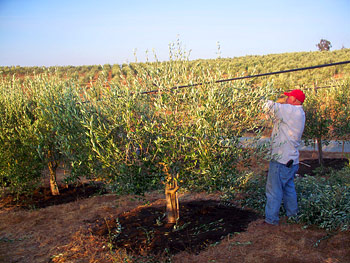Olive Tree Maintenance Services
Maintenance Services
Contact us to help you maintain and care for your olive trees. We have many years of experience and offer affordable rates to businesses and individuals. Call 707-732-6152 to reach our cell.

Irrigation
With its dry summers, irrigation is a necessity in California. A monthly deep watering of home grown trees is normally adequate. Because of its small leaves, with their protective cuticle and slow transpiration, the olive tree survives well even during extended dry periods.
Fertilization
Fertilizing olive trees with additional supplies of nitrogen has proven beneficial. In California, farmers systematically apply fertilizers well ahead of the time flowers develop so the trees can absorb the nitrogen before fruit set. Many growers in Mediterranean countries apply organic fertilizers every other year.
Pruning
Proper pruning is important for the olive. Pruning both regulates production and shapes the tree for easier harvest. The trees can withstand radical pruning, so it is relatively easy to keep them at a desired height. The problem of alternate bearing can also be avoided with carefulpruning every year. It should be kept in mind that the olive never bears fruit in the same place twice, and usually bears on the previous year’s growth. For a single trunk, suckers and any branches growing below the point where branching is desired can be pruned. For the gnarled effect of several trunks, stake out basal suckers and lower branches at the desired angle. Prune flowering branches in early summer to prevent olives from forming. Olive trees can also be pruned to espaliers.
Care and Propagation
None of the cultivated varieties can be propagated by seed. Seed propagated trees revert to the original small-fruited wild variety. The seedling’s can, of course, be grafted or chip budded with material from desired cultivars. The variety of an olive tree can also be changed by bark grafting or top working. Another method of propagation is transplanting suckers that grow at the base of mature trees. However, these would have to be grafted if the suckers grew from the seedling rootstock.
A commonly practiced method is propagation from cuttings. Twelve to fourteen inch long, one to three inch wide cuttings from the two year old wood of a mature tree is treated with a rooting hormone, planted in a light rooting medium and kept moist. Trees grown from such cuttings can be further grafted with wood from another cultivar. Cutting grown trees bear fruit in about four years.